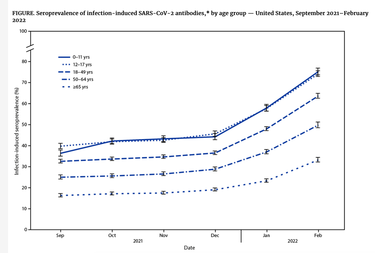Week CXII: Will high rate of COVID-19 infection protect Americans in the long run?
ALBANY COUNTY — This week, as China’s strict zero-COVID policy is under strain, the more relaxed approach in the United States may be what led to the results in a recent report posted by the Centers for Disease Control and Prevention indicating that most Americans have been infected with the virus.
New York State remains a hotspot for COVID-19 but, while the transmission level in Albany County is labeled “high” by the CDC, the number of hospitalizations and deaths remains far lower than with earlier surges.
After three rounds of mandatory testing in Beijing, schools and restaurants were closed this week and a negative test is required to enter public places or use public transportation.
Meanwhile, in the United States, where lockdowns seem a strategy of the past, the CDC last Tuesday posted a report showing that, by February, 60 percent of Americans, including 75 percent of children, had been infected with COVID-19.
The Omicron variant became dominant in December, causing cases nationally to peak “at their highest recorded levels,” the report says.
Since traditional methods of disease surveillance do not capture all COVID cases — some are asymptomatic, not diagnosed, or not reported — the researchers studied antibodies, known as seroprevalence, to understand the incidence of COVID-19.
“As of February 2022, approximately 75% of children and adolescents had serologic evidence of previous infection with SARS-CoV-2, with approximately one third becoming newly seropositive since December 2021,” the report says.
The greatest increases in seroprevalence from September 2021 to February 2022 was in the age groups with the lowest vaccination coverage, the researchers found. They said that lower seroprevalence among adults aged 65 or older, who are at greater risk for severe illness from COVID-19, might also be related to the increased use of additional precautions with increasing age.
The older the age group, the less likely it was to have antibodies.
Some experts believe the widespread previous infection may be why there are fewer serious illnesses from the virus now.
Still, on Tuesday, the CDC restated its guidance that everyone age 2 and older wear masks on trains, planes and buses — a policy already in place in New York State. A federal judge in Florida struck down the federal rule on April 18, which the Justice Department is appealing.
Albany County
New York State, including Albany County, continues to have a high rate of infection compared to the rest of the nation, which the state’s health department has said is caused by two new subvariants of Omicron.
This week, Albany County suffered two COVID-related deaths — a man in his fifties and a man in his eighties — which brings the county’s COVID-19 death toll to 551.
As of Tuesday, as a seven-day average, Albany County had 43.7 cases per 100,000 of population.
This compares with 37.7 last week, 28.3 cases two weeks ago, 21.1 cases three weeks ago, and 11.0 cases per 100,000 four weeks ago — a steady progression upward.
Statewide, the seven-day average is 38.16 cases per 100,000 as a seven-day average. Western New York has the highest count at 58.15 cases and New York City as the lowest at 30.63 cases per 100,000.
Similarly, the less reliable infection rate — the percentage of positive test results — is now at 10.0 percent for Albany Count as a seven-day average.
This compares to 13.5 percent last week, 9.1 percent two weeks ago, 7.5 percent three weeks ago, 3.5 percent four weeks ago, and 2.6 percent five weeks ago.
Statewide, as a seven-day average, the infection rate is 6.79 percent. The region with the highest rate is Western New York at 17.45 percent while the region with the lowest infection rate is New York City at 4.18 percent.
On Friday, April 29, in his twice-weekly press release on COVID, Albany County Executive Daniel McCoy said that, due to New York State closing down its Virtual Call Center that day, “There will be an unknown margin of error in the reporting of our COVID case data as residency discrepancies and duplicative counting of cases may occur.”
The county’s health department, he said, is trying to determine the best way to “clean” the data through computer sorting or filtering.
“The issue of data accuracy is compounded by the lack of reporting of at-home test results which has been a consistent issue since the onset of Omicron,” the release said. “As we have reported previously, hospitalizations and deaths are the leading metrics that many health professionals continue to use; however, if you use daily case count as a tool to make your personal decisions please do so with the understanding that there is a margin of error in this reporting.”
McCoy continued to encourage residents to submit the positive results of at-home COVID tests on the county website, and also continued to urge vaccination.
The percentage of fully vaccinated Albany County residents has barely budged for months; it remains at 74.3 percent, meaning just over a quarter of residents are not fully vaccinated.
McCoy reported on Tuesday that there are 34 county residents hospitalized with the coronavirus, with one in an intensive-care unit.
This compares to 31 a week ago, 30 county residents two weeks ago, 21 county residents hospitalized three weeks ago, and 13 hospitalized with the virus four weeks ago.
While most counties in the nation are labeled by the CDC as having a “low” community level of COVID-19, Albany County, like most of the counties in New York State, continues to be labeled as “high” by the CDC. The community level of COVID-19 is based on new COVID-19 hospital admissions per 100,000 of population as a seven-day total and on the percent of inpatient beds occupied by COVID-19 patients as a seven-day average.
A “high” designation means masks are to be worn indoors in public. Also, last Monday afternoon, Albany County’s health department put out an advisory “strongly recommending all residents, regardless of vaccination status, … wear masks in indoor public spaces, including private businesses.”
Under the CDC’s four-tiered system, based on percentage of positive tests, or infection rate, the entire state of New York is colored red for “high” community transmission of the virus, as is most of New England.
The CDC reports, as of April 30, that New York and New Jersey now have 37.6 percent of their COVID cases caused by the original Omicron variant (BA.2) while 61.9 percent are caused by one of the new subvariants, BA.2.12.1.
Religious education curtailed by pandemic
A study from the Hartford Institute for Religion Research shows that although 90 percent of surveyed congregations have already returned to face-to-face worship, religious education programming is still “far from normal.”
Half of the congregations said they felt the pandemic had caused major disruption to their educational programs. This includes Sunday school, vacation Bible school, church day camps, and adult education.
Smaller churches, those in the mainline tradition, and churches that did not quickly return to a modified in-person education program suffered more during the past two years.
The institute’s third report examining how United States congregations are navigating the pandemic included 615 responses from churches in 31 Christian denominational groups.
Results showed that virtual religious education did not work well for children, though it had benefits in adult educational efforts.
For children’s programs, 82 percent of both the Catholic/Orthodox and Evangelical churches continued meeting in-person during the pandemic, often with modifications. For youth religious education, 75 percent of Catholic/Orthodox and 68 percent of Evangelical congregations continued in-person meetings whereas only 29 percent of mainline churches did so.
Prior to the pandemic, 36 percent of churches offered vacation Bible school or church day camps during the summer. In 2020, that number dropped to 17 percent of congregations, and while that number rebounded back to 36 percent in the summer of 2021, currently only 31 percent of churches plan to offer vacation Bible school in 2022.
Cooling help
On Monday, May 2, eligible New Yorkers could start applying for some of the $15 million in federal funds available through the Home Energy Assistance Program to help low-income individuals and families who lack air-conditioning stay cool during the upcoming summer months.
“In the aftermath of the COVID-19 pandemic, thousands of New York families are still struggling to pay their utility bills, rent, and put food on the table to feed their families,” said Assemblywoman Linda Rosenthal in a statement. “As the warmer months approach, it is vital that we provide hardworking, low-income New Yorkers with relief to help keep cool.”
To qualify for cooling assistance under the amended guidelines, applicants must meet HEAP eligibility criteria and income thresholds, which vary by household size. For instance, a family of four may have a maximum gross monthly income of $5,249 or an annual gross income of $62,983.
Prior to this year, the cooling component of HEAP was available only to income-eligible households with a person suffering from a documented medical condition exacerbated by extreme heat.
The program covers the cost of an air-conditioning unit and installation. Under the expanded eligibility, the cooling component is expected to serve up to 20,000 households throughout the state.
From May 2 to Aug. 31, or until funding runs out, Albany County residents may apply through the county’s Department of Social Services at 162 Washington Ave. in Albany (518-447-7323) or through Cornell Cooperative Extension at Faith Plaza on Route 9W in Ravena (518-756-8650) or 230 Green St. in Albany (518-765-3500).
Assistance is provided on a first-come, first-served basis.
Sales-tax revenues up
Local government sales-tax collections grew by 21.1 percent, or $901 million, in the first quarter of 2022 compared to the same period last year, according to a report released this week by the state’s comptroller, Thomas DiNapoli.
Collections for the three-month period totaled nearly $5.2 billion, with growth at least partially driven by inflation, which hit a 40-year-high in March.
“Local sales tax collections continue to come in strong,” said DiNapoli in a statement, releasing the report. “While local governments are collecting more, they are also dealing with some of the same increased costs that consumers and private businesses are. With prices rising, we’re watching closely to see what impact the rate of inflation and economic volatility is having on New York’s economic recovery.”
Outside New York City, nearly every county had double-digit growth in the first quarter.
Albany County had a 15.3-percent increase for the first quarter, which runs from January through March. In 2021, the county had $68.3 million in sales-tax revenues compared to $78.8 million this year.
The report notes that the recently enacted state budget provides for a partial suspension of certain state taxes on gasoline from June to December 2022, amounting to a reduction of 16 cents per gallon.
“Generally speaking,” the report says, “the sales tax is sensitive to changing economic conditions and often grows with inflation helping to at least partially offset higher costs for local governments. Other sources of local revenue are not as directly affected by the economy, and the property tax — the largest source of revenue for most local governments — is capped at 2 percent growth annually.”



